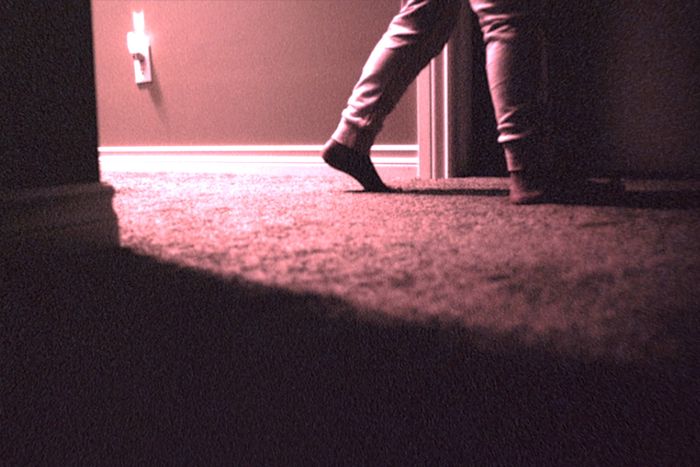
Kyle Edward Ball’s viral indie sensation has an analog aesthetic but was very much born from the internet. Photo: BayView Entertainment
Skinamarink is as hair-raising as it is boring, which doesn’t feel like a failure so much as the goal of this micro-budget effort. An experimental horror movie shot entirely in writer-director Kyle Edward Ball’s childhood home in Edmonton, Skinamarink forgoes standard storytelling to instead try to re-create the sensation of being scared — more precisely, scared when you’re a kid and the night has transformed your bedroom into something alien and the hallway between you and the bathroom into a no-man’s-land full of monsters. The camera often tilts upward to mimic the perspective of a child in bed staring at the dark crevices where the ceiling meets the wall, but even the most feverishly worked-up young mind has to surrender to sleep eventually. Mundanity is built into this nostalgia-infused dread. When 4-year-old Kevin (Lucas Paul) and 6-year-old Kaylee (Dali Rose Tetreault) wake to find their father gone and the windows and doors of their house gradually disappearing, they make a nest of blankets and toys in front of the television, where they watch cartoons — a Saturday-morning ritual, complete with cereal, carried out in a supernatural stasis.
When Skinamarink sets out to actively scare, like it does in an incredible, peer-out-from-between-your-fingers sequence when an unsettling voice lures Kaylee upstairs to her parents’ room, it’s very good at it. But the idea of the movie is more beguiling than the overall experience of watching it. All those long, atmospheric shots of the grainy darkness beyond open doorways and the flickering TV light from the back of the sofa lose their impact over the film’s run time. What’s more interesting about Skinamarink is that it traffics in horror concepts born from, or at least obsessed over by, the internet. Ball got his start making YouTube shorts inspired by commenters’ nightmares, and has been compared to David Lynch. The textured soundscapes and squishy dream logic of Skinamarink might bring to mind Eraserhead, but a more immediate relative of the film is last year’s We’re All Going to the World’s Fair. Like Jane Schoenbrun’s film, which revolves around a haunting social-media challenge, Skinamarink’s ideas about what’s unsettling — like the curdling of childhood memories and hollowing out of everyday settings — feel inspired by the teeming universe of online horror that sprawls across sub-Reddits and video platforms.
Schoenbrun’s feature takes place almost entirely in the home of its young lead as well, but when it does head outside, it never shows another human being in its tableaus of big-box stores and multilane roads. Similarly, Skinamarink pushes its few human characters to the corners of the frame (when it shows them at all), shooting them from behind or in fragments. The house is the point, this bustling domestic place turned into an eerie limbo. Those unhurried shots of the upstairs hallway, the craggy Lego landscapes across a stretch of carpet, and a dining-room chair mysteriously attached to the ceiling all recall, more than anything, the liminal-spaces aesthetic that sprang out of message boards like 4Chan and Reddit a few years ago and has since spread across the larger internet. The user-sourced images of empty public and transitional locations, nighttime classrooms, seemingly endless fluorescent-lit hallways and vacant parking lots, are an obvious influence for Skinamarink, to the point where Ball has described the internet as his “co-director.” These barren spaces are invitingly apocalyptic, not because they’re overgrown and decayed, but because they aren’t. In them, it’s as though everyone has been raptured, or as though you’ve somehow slipped through a passageway between worlds into a backstage of reality.
The internet has reciprocated this relationship by turning Skinamarink into a low-key viral sensation on the basis of its trailer (as well as pirated copies circulated after a streaming-festival mishap). It’s fitting that Skinamarink is coming out right on the tail of Blumhouse’s M3gan, which also got traction online before it became a hit in theaters, and happened to pander skillfully to exactly the audience that memed it into wider cultural awareness. For all the fretting about the future of movies being eroded by competition with internet content, it’s horror, with its porous connection with the online world, that has been the one non-superhero genre to reliably get people into theaters. With its deliberate pace, non-narrative structure, and absence of not just stars but shots of the actors’ faces, Skinamarink is in many ways the opposite of M3gan. And yet, despite its 1995 setting and all the ways it cloaks itself in the analog, from the grain effects to the landline that plays a pivotal role in the final section, Skinamarink is very much of the digital age. It’s an example of how the sprawling, crowdsourced horror sensibilities of the internet can be refined by someone who came up immersed in them, creating a work that’s neither “elevated horror” nor mainstream, but something new.
"Movies" - Google News
January 14, 2023 at 04:29AM
https://ift.tt/vZtmzO1
Skinamarink Isn't Like Other Horror Movies - Vulture
"Movies" - Google News
https://ift.tt/cgS5adx
Bagikan Berita Ini














0 Response to "Skinamarink Isn't Like Other Horror Movies - Vulture"
Post a Comment